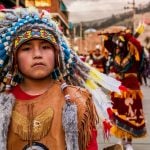North Plains Indian Clothing (Photo Diary)
The Northern Plains include what is now North and South Dakota, Eastern Montana, northeastern Wyoming, and the Canadian provinces of Alberta and Saskatchewan.
The basic dress for women was a wrap-around skirt. During inclement weather a poncho-cape was often worn. Among many of the Northern Plains tribes—Sarsi, Blackfoot, Assiniboine, Dakota, Sanpoil, Mandan, and Hidatsa—the women would make two-hide dresses by matching two hides of deer, elk, or bighorn sheep. Clothing was often decorated with quillwork or rows of animal teeth.
Deerskin was most often used in making clothing, but for winter clothing buffalo skin might be used. The Blackfoot kept their skin clothing clean by using clay. A white clay would be used on white skins and a yellow clay on the smoked skins. Anthropologist John Ewers, in his book Blackfeet Crafts, reports:
“The clay was moistened with water and rubbed over the surface of the skin garments. Then the whole garment was rubbed briskly with a bone or rock and hung up to dry.”
This process removed dirt, grease, and stains from the garment.
To make white buckskin, the Crow used the thermal residue from the bubbling springs or paint pots in Yellowstone National Park. The material is dark brown when it is bubbling, but when dry it becomes pure white.
With regard to beadwork designs on clothing among the Northern Plains tribes in Alberta, Richard Green, in an article in Whispering Wind, writes:
“Beadwork decoration consisted either of bold geometric design units, or sometimes stylized floral compositions, almost invariably in the couched overlay technique.”
While the designs might be symbolic, they often were not. In his book The Cheyenne Indians: Their History and Lifeways, George Bird Grinnell writes:
“Often a woman makes a bead or quillwork design merely because she thinks it is pretty, to satisfy her own idea of beauty.”
Shown below are some of the items of Plains Indian clothing which are on display at the Portland Art Museum.
Women’s Dress
 Shown above is a Sioux dress made in 1820. It features glass beads on hide.
Shown above is a Sioux dress made in 1820. It features glass beads on hide.
In her book Encyclopedia of American Indian Costume, Josephine Paterek reports:
“The average Sioux woman prided herself not only on the workmanship of her sewing, quilling, and beading, but also on the individuality of her garments.”
 Shown above is a Crow woman’s dress made about 1885. The use of elk’s teeth for decoration was common.
Shown above is a Crow woman’s dress made about 1885. The use of elk’s teeth for decoration was common.
Josephine Paterek reports:
“Elk teeth were the most common decoration, with about three hundred being the usual number, but some had as many as a thousand teeth; these were applied in concentric arcs on both the back and front of the dress. Considering that one hundred elk teeth would buy a good horse, these were costly dresses, and it is not surprising that imitation elk teeth were made of bone.”
Moccasins
Two basic kinds of moccasins were used: a soft-soled one-piece moccasin in which the cut-out leather was folded so that there would be a single seam along the outer edge of the foot, and a hard-sole, two-piece moccasin in which the soles were made from buffalo hide. Josephine Paterek reports:
“It is strange that the Indians wore right and left moccasins at a time when the whites were still struggling with the discomfort of shoes made alike.”
Josephine Paterek also writes:
“Ceremonial moccasins were often painted and decorated with fringes and bands of quillwork. Women’s moccasins were cut similar to the men’s, but the ankle flap was more common on the women’s.”
 Shown above are Arapaho moccasins made about 1890. They are decorated with glass beads and are made from recycled parfleche with rawhide soles.
Shown above are Arapaho moccasins made about 1890. They are decorated with glass beads and are made from recycled parfleche with rawhide soles.  Shown above are Santee Sioux moccasins made about 1890. They are decorated with porcupine quill.
Shown above are Santee Sioux moccasins made about 1890. They are decorated with porcupine quill.
Bags
 Shown above is a Cheyenne pipe bag made about 1890. It is decorated with glass beads and porcupine quill.
Shown above is a Cheyenne pipe bag made about 1890. It is decorated with glass beads and porcupine quill.  Shown above is a Blackfoot bandolier bag made about 1940.
Shown above is a Blackfoot bandolier bag made about 1940.




